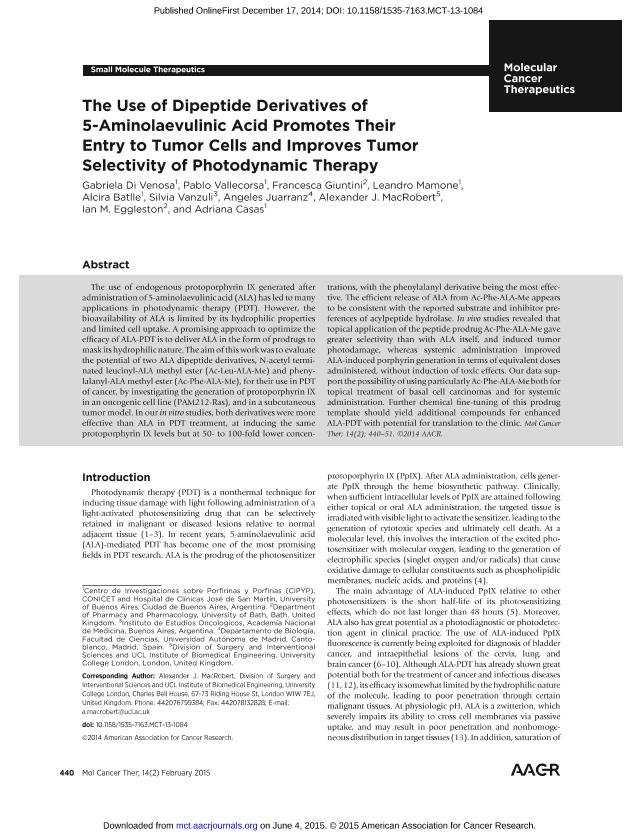Artículo
The use of dipeptide derivatives of 5-aminolaevulinic acid promotes their entry to tumor cells and improves tumor selectivity of photodynamic therapy
Di Venosa, Gabriela Mariana ; Vallecorsa, Pablo Daniel
; Vallecorsa, Pablo Daniel ; Giuntini, Francesca; Mamone, Leandro Ariel
; Giuntini, Francesca; Mamone, Leandro Ariel ; Batlle, Alcira María del C.
; Batlle, Alcira María del C. ; Vanzuli, Silvia; Juarranz, Ángeles; MacRobert, Alexander J.
; Vanzuli, Silvia; Juarranz, Ángeles; MacRobert, Alexander J. ; Egglestone, Ian M.; Casas, Adriana Gabriela
; Egglestone, Ian M.; Casas, Adriana Gabriela
 ; Vallecorsa, Pablo Daniel
; Vallecorsa, Pablo Daniel ; Giuntini, Francesca; Mamone, Leandro Ariel
; Giuntini, Francesca; Mamone, Leandro Ariel ; Batlle, Alcira María del C.
; Batlle, Alcira María del C. ; Vanzuli, Silvia; Juarranz, Ángeles; MacRobert, Alexander J.
; Vanzuli, Silvia; Juarranz, Ángeles; MacRobert, Alexander J. ; Egglestone, Ian M.; Casas, Adriana Gabriela
; Egglestone, Ian M.; Casas, Adriana Gabriela
Fecha de publicación:
02/2015
Editorial:
American Association for Cancer Research
Revista:
Molecular Cancer Therapeutics
ISSN:
1535-7163
Idioma:
Inglés
Tipo de recurso:
Artículo publicado
Clasificación temática:
Resumen
The use of endogenous protoporphyrin IX generated after administration of 5-aminolaevulinic acid (ALA) has led to many applications in photodynamic therapy (PDT). However, the bioavailability of ALA is limited by its hydrophilic properties and limited cell uptake. A promising approach to optimize the efficacy of ALA-PDT is to deliver ALA in the form of prodrugs to mask its hydrophilic nature. The aim of this work was to evaluate the potential of two ALA dipeptide derivatives, N-acetyl terminated leucinyl-ALA methyl ester (Ac-Leu-ALA-Me) and phenylalanyl-ALA methyl ester (Ac-Phe-ALA-Me), for their use in PDT of cancer, by investigating the generation of protoporphyrin IX in an oncogenic cell line (PAM212-Ras), and in a subcutaneous tumor model. In our in vitro studies, both derivatives were more effective than ALA in PDT treatment, at inducing the same protoporphyrin IX levels but at 50- to 100-fold lower concentrations, with the phenylalanyl derivative being the most effective. The efficient release of ALA from Ac-Phe-ALA-Me appears to be consistent with the reported substrate and inhibitor preferences of acylpeptide hydrolase. In vivo studies revealed that topical application of the peptide prodrug Ac-Phe-ALA-Me gave greater selectivity than with ALA itself, and induced tumor photodamage, whereas systemic administration improved ALA-induced porphyrin generation in terms of equivalent doses administered, without induction of toxic effects. Our data support the possibility of using particularly Ac-Phe-ALA-Me both for topical treatment of basal cell carcinomas and for systemic administration. Further chemical fine-tuning of this prodrug template should yield additional compounds for enhanced ALA-PDT with potential for translation to the clinic.
Palabras clave:
Photodynamic Therapy
,
Ala
,
Tumor Cells
Archivos asociados
Licencia
Identificadores
Colecciones
Articulos(CIPYP)
Articulos de CENTRO DE INVEST. SOBRE PORFIRINAS Y PORFIRIAS
Articulos de CENTRO DE INVEST. SOBRE PORFIRINAS Y PORFIRIAS
Citación
Di Venosa, Gabriela Mariana; Vallecorsa, Pablo Daniel; Giuntini, Francesca; Mamone, Leandro Ariel; Batlle, Alcira María del C.; et al.; The use of dipeptide derivatives of 5-aminolaevulinic acid promotes their entry to tumor cells and improves tumor selectivity of photodynamic therapy; American Association for Cancer Research; Molecular Cancer Therapeutics; 14; 2; 2-2015; 440-451
Compartir
Altmétricas



